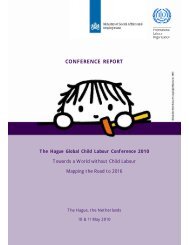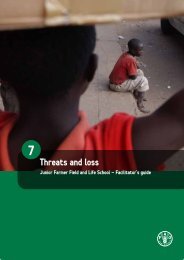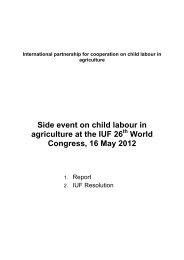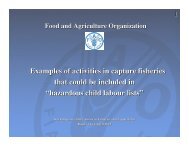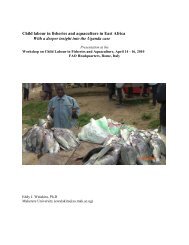Mainstreaming responses to the girl child in agriculture - Food ...
Mainstreaming responses to the girl child in agriculture - Food ...
Mainstreaming responses to the girl child in agriculture - Food ...
Create successful ePaper yourself
Turn your PDF publications into a flip-book with our unique Google optimized e-Paper software.
A traditionalist perception that women and <strong>girl</strong>s produce for <strong>the</strong> household ra<strong>the</strong>r<br />
than <strong>the</strong> market prevailed for many years. However it is now fully acknowledged that a<br />
high proportion of rural women and <strong>girl</strong>s are regularly wage-dependent, tak<strong>in</strong>g on<br />
seasonal or casual work <strong>to</strong> supplement low <strong>in</strong>comes with paid work on o<strong>the</strong>r farms or<br />
plantations (ILO, 2003). In some places, <strong>child</strong>ren’s ‘waged’ work <strong>in</strong> <strong>agriculture</strong> can be<br />
absorbed <strong>in</strong><strong>to</strong> ‘piece work based on family work units (ILO, 2006 pg 37-38). However,<br />
<strong>the</strong> evidence would <strong>in</strong>dicate that <strong>child</strong>ren can often beg<strong>in</strong> work as young as 11 years on<br />
banana, sugarcane or tea plantations (Cook, 2008). If hired as a <strong>child</strong> worker, some<br />
studies have found that, on average, <strong>girl</strong>s (like <strong>the</strong>ir older sisters and mo<strong>the</strong>rs) are often<br />
paid less than boys for do<strong>in</strong>g <strong>the</strong> same job suggest<strong>in</strong>g that gender <strong>in</strong>equities <strong>in</strong> waged<br />
employment span all age groups.<br />
Sec<strong>to</strong>r specific studies and o<strong>the</strong>r research provide evidence of <strong>the</strong> extent and<br />
conditions of <strong>girl</strong> <strong>child</strong> labour <strong>in</strong> for example certa<strong>in</strong> agricultural commodities. Some<br />
such studies on cot<strong>to</strong>n, coffee and tea are summarised below.<br />
3.2 Girls and cot<strong>to</strong>n cultivation<br />
A ten-country review by <strong>the</strong> International Cot<strong>to</strong>n Advisory Committee (ICAC)<br />
highlights gender and <strong>girl</strong> <strong>child</strong> labour issues <strong>in</strong> cot<strong>to</strong>n cultivation (ICAC, 2008). In <strong>the</strong><br />
Indian review for <strong>in</strong>stance, female labour demand has peaks of demand at weed<strong>in</strong>g and<br />
harvest<strong>in</strong>g time. Several reports mentioned by <strong>the</strong> ICAC focus on <strong>the</strong> use of bonded<br />
young female labourers (7-14 years) for F1 hybrid cot<strong>to</strong>nseed production, as <strong>the</strong> seed<br />
production process requires hand emasculation and cross-poll<strong>in</strong>ation of cot<strong>to</strong>n flowers.<br />
Apart from be<strong>in</strong>g denied <strong>the</strong>ir freedom, a basic human right, this activity can expose<br />
<strong>girl</strong>s <strong>to</strong> pesticides of different <strong>to</strong>xicity classes, which are extensively used <strong>in</strong> cot<strong>to</strong>n<br />
grow<strong>in</strong>g systems. Depend<strong>in</strong>g on <strong>the</strong> safety class and dose exposure of <strong>the</strong> chemical<br />
pesticide, such exposure can result <strong>in</strong> immediate and long–term effects and may be most<br />
critical for <strong>the</strong> reproductive systems of pre-pubescent <strong>girl</strong>s (ILO, 2009). The ICAC cite<br />
reports suggest<strong>in</strong>g that women and <strong>child</strong>ren are most vulnerable <strong>to</strong> pesticide exposure 12 .<br />
The ICAC also highlight a study by Manc<strong>in</strong>i et al (2005) which noted that <strong>the</strong> typical<br />
female task <strong>in</strong> cot<strong>to</strong>n farm<strong>in</strong>g <strong>in</strong>cluded mix<strong>in</strong>g concentrated chemicals and refill<strong>in</strong>g<br />
spray<strong>in</strong>g tanks. Manc<strong>in</strong>i’s study concluded that <strong>the</strong>se prepara<strong>to</strong>ry tasks are as hazardous<br />
as direct application of <strong>the</strong> pesticide. The participation of <strong>girl</strong>s <strong>in</strong> cot<strong>to</strong>n harvest<strong>in</strong>g is<br />
also commonplace <strong>in</strong> cot<strong>to</strong>n-grow<strong>in</strong>g regions of Punjab <strong>in</strong> Pakistan. In some <strong>in</strong>stances<br />
rural schools may close dur<strong>in</strong>g <strong>the</strong> cot<strong>to</strong>n-harvest<strong>in</strong>g season. Dur<strong>in</strong>g <strong>the</strong> harvest<strong>in</strong>g<br />
season, female piece-rate cot<strong>to</strong>n pickers often br<strong>in</strong>g <strong>the</strong>ir younger <strong>child</strong>ren, especially<br />
female <strong>child</strong>ren, <strong>to</strong> help <strong>in</strong> <strong>the</strong> fields (ICAC, 2008). Such <strong>in</strong>termittent <strong>child</strong> labour is a<br />
common feature of <strong>child</strong> labour <strong>in</strong> <strong>agriculture</strong> and rural areas, and arguments are often<br />
put forward for rural schools <strong>to</strong> adjust timetables <strong>in</strong> order <strong>to</strong> accommodate seasonal<br />
agricultural work <strong>in</strong> particular localities 13 .<br />
A study by an NGO, <strong>the</strong> India Committee of <strong>the</strong> Ne<strong>the</strong>rlands noted that <strong>the</strong><br />
<strong>in</strong>troduction of F1 hybrid cot<strong>to</strong>nseeds production <strong>in</strong> <strong>the</strong> early 1970s <strong>in</strong> India, contributed<br />
<strong>to</strong> <strong>the</strong> rise <strong>in</strong> productivity and quality of cot<strong>to</strong>n, and also generated a substantial amount<br />
of additional employment <strong>in</strong> <strong>the</strong> agricultural sec<strong>to</strong>r. However, much of <strong>the</strong> extra<br />
employment generated was <strong>the</strong> hir<strong>in</strong>g of female <strong>child</strong>ren as bonded labourers. As many<br />
as an estimated 450,000 <strong>child</strong>ren, <strong>in</strong> <strong>the</strong> age group of 6 <strong>to</strong> 14 years, were employed <strong>in</strong><br />
U. Murray, P. Hurst - Draft for discussion - 8







